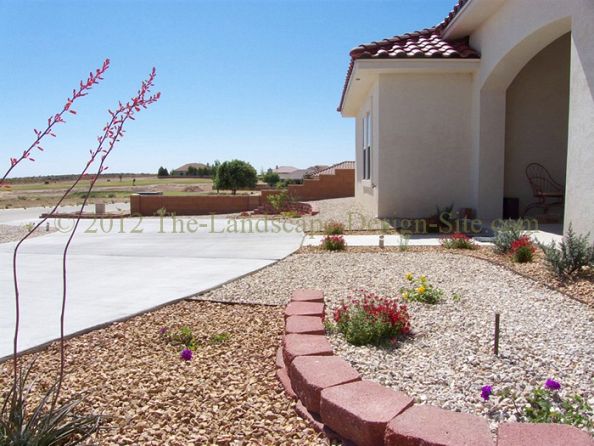Converting to Xeriscaping
With a drought just declared in California, I have my garden on the brain, and I'm not the only one. Many people in my community have allowed their gardens to die over the last few months in order to save water, which is a grim reminder that even when you try to plan ahead with native plants, succulents, and other drought-tolerant plants, your garden can still have a tough time in dry weather. Plus, all those adorable plants you couldn't resist even though you knew they'd need watering just hit the dust -- sorry, plants!
If that's not a motivation to clean up your act and get into xeriscaping, I don't know what is. Across the Western States, water is going to become a growing issue in the coming years, and rather than entering a vicious cycle of planting and replanting, enjoying water-hungry plants and then sadly watching them wither, it's time to convert to a xeriscape. That said, converting a garden can be hard, scary work, especially if you're invested in your current setup...or you think dry gardens are ugly.
I took a look at some xeriscaping projects on Hometalk for inspiration, and to show that you or your San Diego landscapers have considerable room for playing around when it comes to creating a beautiful garden.
 The Seasoned Homemaker lives in Texas, where water availability is a consistent issue. She opted to xeriscape when she moved in, taking out the existing grass, putting down a weed barrier, and establishing a series of graveled paths, a dry river, and woodchip beds for planting. There are a few things about her garden that are worth noting. One is the flowing, fluid nature of her hardscaping, which suggests a natural environment and makes her garden less rigid. Another is her decision to mix ornamental plantings with vegetables. Although her garden looks a little sterile now, as it gets established and her plants have time to settle in, it will turn lush and beautiful; but she won't be wasting water to get it that way.
The Seasoned Homemaker lives in Texas, where water availability is a consistent issue. She opted to xeriscape when she moved in, taking out the existing grass, putting down a weed barrier, and establishing a series of graveled paths, a dry river, and woodchip beds for planting. There are a few things about her garden that are worth noting. One is the flowing, fluid nature of her hardscaping, which suggests a natural environment and makes her garden less rigid. Another is her decision to mix ornamental plantings with vegetables. Although her garden looks a little sterile now, as it gets established and her plants have time to settle in, it will turn lush and beautiful; but she won't be wasting water to get it that way.
 This homesite uses retaining walls to manage the slope of a circular driveway and create flowing, fluid spaces for planting. As before, this is a newly-planted garden, which gives the plants a somewhat isolated and sterile look, but that will change as they mature and have a chance to spread. Critically, this garden has excellent drainage (in the event of flash storms), with mulch to help plants retain moisture during dry weather. Again, it won't have high water demands.
This homesite uses retaining walls to manage the slope of a circular driveway and create flowing, fluid spaces for planting. As before, this is a newly-planted garden, which gives the plants a somewhat isolated and sterile look, but that will change as they mature and have a chance to spread. Critically, this garden has excellent drainage (in the event of flash storms), with mulch to help plants retain moisture during dry weather. Again, it won't have high water demands.
 Plants like this spreading lantana, for example, come in a range of colors and thrive in dry conditions. They're great for xeriscaping because once they're established, they're nearly indestrucible. They have a low shrub-like growth habit, with sprawling vines that will add much-needed color and greenery to the landscape.
Plants like this spreading lantana, for example, come in a range of colors and thrive in dry conditions. They're great for xeriscaping because once they're established, they're nearly indestrucible. They have a low shrub-like growth habit, with sprawling vines that will add much-needed color and greenery to the landscape.
 Rockroses are another great choice. They're colorful, with a sagey, dusty odor that's quite lovely on dry days. If they're healthy and they like where they are, they can also get quite tall, making them great for hedges and towering background plantings. Incidentally, rockroses are not deer resistant.
Rockroses are another great choice. They're colorful, with a sagey, dusty odor that's quite lovely on dry days. If they're healthy and they like where they are, they can also get quite tall, making them great for hedges and towering background plantings. Incidentally, rockroses are not deer resistant.
 Yucca is another low-water gardening classic. It can grow to a formidable size, and while it's a little intimidating, it makes a great background planting. Plus, these plants will live for decades as long as they're healthy!
Yucca is another low-water gardening classic. It can grow to a formidable size, and while it's a little intimidating, it makes a great background planting. Plus, these plants will live for decades as long as they're healthy!
These are just the beginning when it comes to heat and drought-tolerant gardening and plants. Xeriscaping doesn't have to be ugly, and it needn't be terrifying, either: you can do it! Think of it as remodeling for your garden, and look forward to the challenge.
Katie Marks writes for Networx.com.
Looking for a Pro? Call us (866) 441-6648

Landscaping Average Costs
Landscapers Experiences

Tree Removal So Fast And Efficient It Didn’t Even Wake Our Newborn

Yard Clean Up Left Our Lawn Looking Fantastic



